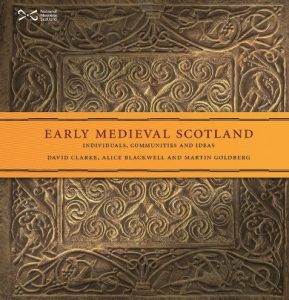Clarke, David, Blackwell, Alice and Goldberg, Martin. 2012, Early Medieval Scotland: Individuals, Communities and Ideas, Edinburgh: National Museums Scotland, xx + 232 pages (hb). ISBN 978-1-905267-63-7. Reviewed by Pamela O’Neill.
The best thing about this book is undoubtedly the illustrations. It clearly aspires to join the ‘coffee-table book’ genre, and succeeds: production is of a very high standard; the large square page size allows for beautifully planned and executed photographs; the attractive cover features foil highlights, and the paper stock is of high quality. The Glenmorangie Company is sure to have played a large part in this: facilitating highly visible artefacts like this book may be considered a stroke of marketing genius. Glenmorangie’s total contribution to the National Museum of Scotland includes funding an impressive array of research, some of it underlying the content of this book, and early medieval scholars might well consider that the partnership has far exceeded a clever piece of marketing or the purchase price of a brand emblem. 
The fine illustrations (many of objects not routinely displayed) are not the only impressive or important thing about this book. Setting out to divert thinking about artefacts from traditional, historically informed channels, the book invites us to consider early medieval objects as having distinctive things to tell us: things that might not relate closely to what documentary sources have to say, or to their preoccupations. In that sense, the book is not only a presentation of the outcomes of research but an exploration of directions in which research might be guided.
Chapter 1, ‘Individuals’ by Alice Blackwell, is perhaps the least successful in this pursuit. A very interesting discussion of brooches is marred by unquestioning acceptance of the very questionable assumption that the brooch-wearers on the Hilton-of-Cadboll and Kirriemuir sculptured stones are women (it should be noted that Martin Goldberg does question this in his chapter). This is compounded by an unreferenced statement that in Anglo-Saxon England women wore brooches and men did not. In this context, setting aside the evidence from early Irish law might be useful for extricating objects from textual complication, but not for seeking to differentiate Scotland from Ireland in the early medieval period: it is extremely unlikely that what we call Irish law did not apply in most of what is now Scotland. Indeed, the subsequent discussion of brooches as surety assumes that the practice (known only from Irish law texts) applied in Scotland as well as Ireland. Unfortunately, though, the discussion fails to distinguish between brooch-as-object and the law texts’ brooch-as-bearer-of-economic-value.
David Clarke’s Chapter 2, ‘Communities’, is a wonderfully nuanced problematisation of established approaches to material culture, in terms both of objects and of interpretation of sites. Some highlights include: stressing our inability to properly distinguish between ecclesiastical and secular sites; questioning the interpretation of monument types such as the purported shrines exemplified by the St Andrews sarcophagus and the supposedly free-standing cross slabs with projecting tenons; pointing out inconsistencies in existing interpretations of craft-working sites, their geographical and political distribution. One minor flaw is the unreferenced assertion that historical texts claim that Dál Riata in Scotland was created by settlement from northern Ireland. This is contrasted with the lack of material evidence for Irish settlement. It is important to note that documentary evidence does not unequivocally state that Scottish Dál Riata was the result of settlement from Ireland.
‘Ideas and Ideologies’, Chapter 3, by Martin Goldberg is a fascinating and thought-expanding attempt to interpret what messages objects were intended to convey. This chapter has a few small flaws. One is the perpetuation of Ewen Campbell’s suggestion that the cross-incised quern from Dunadd must be closely related to similar crosses from Argyll, and particularly Iona, while overlooking the vast corpus of incised crosses throughout Scotland and beyond, many of which are stylistically comparable to these. Another is the insistence that Pictish symbols are a script. On the other hand, the chapter contains many excellent ideas, including the idea that the absence of pre-Christian religious structures in Scotland may explain the absence of Christian ones, and the very impressive discussion of Easter symbolism in the cross-slabs.
This book’s hope, eloquently expressed at page xx, is to ‘set in motion a resurgence of interest in the material culture of the period as a primary source of evidence’. In other words, it is time to stop looking to material culture merely to corroborate what texts tell us, and to start giving voice to the interesting stories that objects have to tell. This book makes some progress towards that laudable aim, through its beautiful illustrations and its insightful text.
Dr Pamela O’Neill FSA Scot is an honorary research associate in Celtic Studies at the University of Sydney, and principal of the Australian School of Celtic Learning. She is series editor of the Sydney Series in Celtic Studies and co-editor of the Australian Celtic Journal, and was founder, president and journal editor of the Australian Early Medieval Association.
